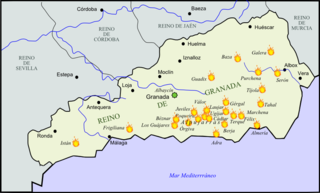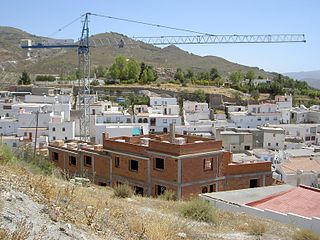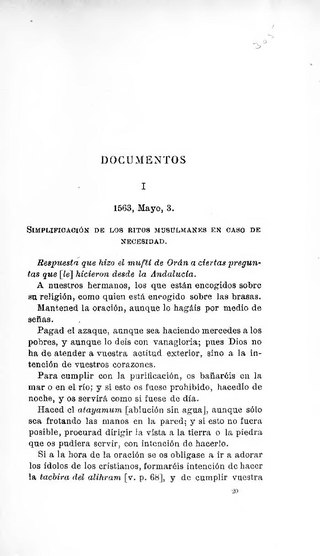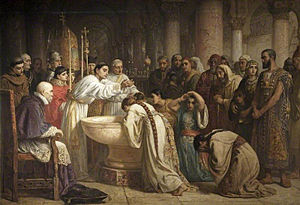
Granada is the capital city of the province of Granada, in the autonomous community of Andalusia, Spain. Granada is located at the foot of the Sierra Nevada mountains, at the confluence of four rivers, the Darro, the Genil, the Monachil and the Beiro. Ascribed to the Vega de Granada comarca, the city sits at an average elevation of 738 m (2,421 ft) above sea level, yet is only one hour by car from the Mediterranean coast, the Costa Tropical. Nearby is the Sierra Nevada Ski Station, where the FIS Alpine World Ski Championships 1996 were held.

Moriscos were former Muslims and their descendants whom the Catholic Church and Habsburg Spain commanded to forcibly convert to Christianity or face compulsory exile after Spain outlawed Islam. Spain had a sizeable Muslim population, the mudéjars, in the early 16th century.

Aben Humeya (1520–1569), also known as Muhammad ibn Umayyah, was a Morisco leader who commanded the Morisco Revolt against Philip II of Spain in the Alpujarras region, near Granada.

Francisco Jiménez de Cisneros, OFM was a Spanish cardinal, religious figure, and statesman. Starting from humble beginnings he rose to the heights of power, becoming a religious reformer, twice regent of Spain, Cardinal, Grand Inquisitor, promoter of the Crusades in North Africa, and founder of the Alcalá University. Among his intellectual accomplishments, he is best known for funding the Complutensian Polyglot Bible, the first printed polyglot version of the entire Bible. He also edited and published the first printed editions of the missal and the breviary of the Mozarabic Rite, and established a chapel with a college of thirteen priests to celebrate the Mozarabic Liturgy of the Hours and Eucharist each day in the Toledo Cathedral.

The Alpujarra is a natural and historical region in Andalusia, Spain, on the south slopes of the Sierra Nevada and the adjacent valley. The average elevation is 1,200 metres (4,000 ft) above sea level. It extends over two provinces, Granada and Almería; it is sometimes referred to in the plural as "Las Alpujarras". There are several interpretations of this Arabic-origin name: the most convincing is that it derives from al-basharāt (البَشَرَات), meaning something like "sierra of pastures". The administrative centre of the part in Granada is Órgiva, while that of the part in Almería is Alhama de Almería.
This is a timeline of notable events during the period of Muslim presence in Iberia, starting with the Umayyad conquest in the 8th century.

The second rebellion of the Alpujarras, sometimes called the War of the Alpujarras or the Morisco Revolt, was the second such revolt against the Castilian Crown in the mountainous Alpujarra region and on the Granada Altiplano region, northeast of the city of Granada. The rebels were Moriscos, the nominally Catholic descendants of the Mudéjares following the first rebellion of the Alpujarras (1499–1501).

The Treaty of Granada, also known as the Surrender of Granada or the Capitulations, was signed and ratified on November 25, 1491, between Boabdil, the sultan of Granada, and Ferdinand and Isabella, the King and Queen of Castile, León, Aragon and Sicily. It ended the Granada War, which had started in 1482 and culminated in the siege and battle of Granada, which began in spring 1491.

Laujar de Andarax is a municipality of Almería province, in the autonomous community of Andalusia, Spain.

The Albaicín, also spelled Albayzín, is a neighbourhood of Granada, Spain. It is centered around a hill on the north side of the Darro River which passes through the city. The neighbourhood is notable for its historic monuments and for largely retaining its medieval street plan dating back to the Nasrid period, although it nonetheless went through many physical and demographic changes after the end of the Reconquista in 1492. It was declared a World Heritage Site in 1994, as an extension of the historic site of the nearby Alhambra.

The Emirate of Granada, also known as the Nasrid Kingdom of Granada, was an Islamic polity in the southern Iberian Peninsula during the Late Middle Ages, ruled by the Nasrid dynasty. It was the last independent Muslim state in Western Europe.

The Granada War, also called Spanish Christian–Muslim War of 1481–1492, was a series of military campaigns between 1481 and 1492 during the reign of the Catholic Monarchs, Isabella I of Castile and Ferdinand II of Aragon, against the Nasrid dynasty's Emirate of Granada. It ended with the defeat of Granada and its annexation by Castile, ending the last remnant of Islamic rule on the Iberian peninsula.
The monfíes were moriscos who lived during the sixteenth and seventeenth centuries in the mountains around Granada.

The Kingdom of Granada was a territorial jurisdiction of the Crown of Castile from the conclusion of the Reconquista in 1492 until Javier de Burgos' provincial division of Spain in 1833. This was a "kingdom" ("reino") in the second sense given by the Diccionario de la lengua española de la Real Academia Española: the Crown of Castile consisted of several such kingdoms. Its extent is detailed in Gelo del Cabildo's 1751 Respuestas Generales del Catastro de Ensenada (1750–54), which was part of the documentation of a census. Like the other kingdoms within Spain, the Kingdom of Granada was abolished by the 1833 territorial division.

The Madrasa of Granada also known as the Palacio de la Madraza or the MadrasaYusufiyya, is a historic building and former madrasa in Granada, Spain. It was founded in 1349 by the Nasrid monarch Yusuf I, Sultan of Granada. The building is currently part of the University of Granada and is the seat of the Real Academia de Bellas Artes de Nuestra Señora de las Angustias.

Hernando de Talavera, O.S.H. was a Spanish clergyman and councilor to Queen Isabel of Castile. He began his career as a monk of the Order of Saint Jerome, was appointed the queen's confessor and with her support and patronage, became the Archbishop of Granada.

The Oran fatwa was a responsum fatwa, or an Islamic legal opinion, issued in 1502 to address the crisis that occurred when Muslims in the Crown of Castile, in present-day Spain, were forced to convert to Christianity in 1500–1502. It was authored by mufti Ahmad ibn Abi Jum'ah, an Algerian scholar of Islamic law of the Maliki school; the term "Oran fatwa" was applied by modern scholars, due to the word "Al-Wahrani" that appears in the text as part of the author's name.

The forced conversions of Muslims in Spain were enacted through a series of edicts outlawing Islam in the lands of the Spanish Monarchy. This persecution was pursued by three Spanish kingdoms during the early 16th century: the Crown of Castile in 1500–1502, followed by Navarre in 1515–1516, and lastly the Crown of Aragon in 1523–1526.

The Mudéjar revolt of 1264–1266 was a rebellion by the Muslim populations (Mudéjares) in the Lower Andalusia and Murcia regions of the Crown of Castile. The rebellion was in response to Castile's policy of relocating Muslim populations from these regions and was partially instigated by Muhammad I of Granada. The rebels were aided by the independent Emirate of Granada, while the Castilians were allied with Aragon. Early in the uprising, the rebels managed to capture Murcia and Jerez, as well as several smaller towns, but were eventually defeated by the royal forces. Subsequently, Castile expelled the Muslim populations of the reconquered territories and encouraged Christians from elsewhere to settle their lands. Granada became a vassal of Castile and paid an annual tribute.

Mudéjar were Iberian Muslims who remained in Iberia in the late medieval period following the Christian reconquest. It is also a term for Mudéjar art, which was much influenced by Islamic art, but produced typically by Christian craftsmen for Christian patrons. Mudéjar was used in contrast to both Muslims in Muslim-ruled areas and Moriscos, who were often forcibly converted and may or may not have continued to secretly practice Islam. The corresponding term for Christians living under Muslim rule is Mozarabs.




















